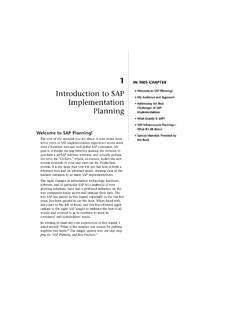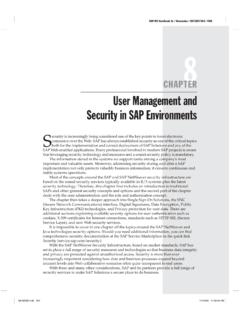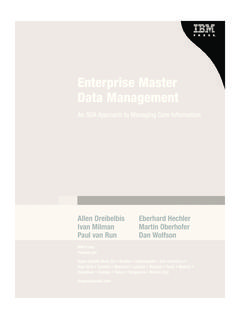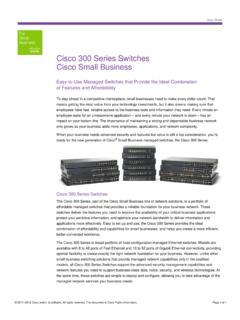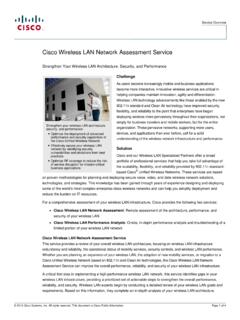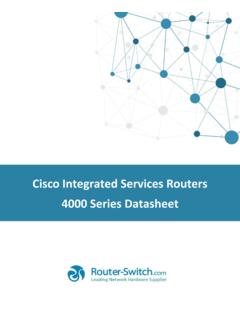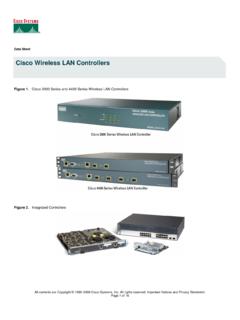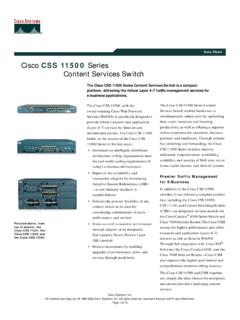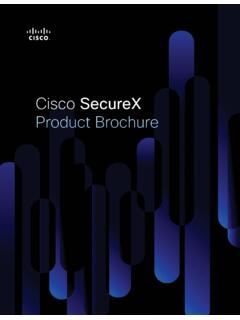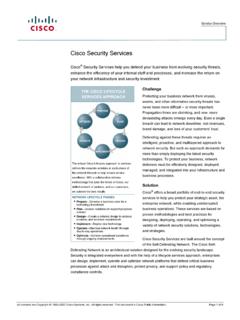Transcription of Cisco Unified Communications Manager Architecture
1 CHAPTER1 Cisco Unified Communications Manager ArchitectureA Cisco Unified Communications deployment relies on Cisco Unified Communications Manager (CUCM) (formerly known as Cisco Unified CallManager) for its call-processing and call-routing functions. Understanding the role that CUCM plays in a converged network from a system, software, and hardware perspective is necessary for successfully installing and configuring lesson introduces and describes the role, Architecture , hardware and software requirements, and the licensing model of the ObjectivesUpon completing this chapter, you will have an understanding of the CUCM Architecture and be able to meet the following objectives: Describe the components of a Cisco Unified Communications solution and each component s functionality. Describe the Architecture and role of CUCM. Describe the hardware requirements for CUCM. Describe the characteristics of the CUCM operating system. Describe the characteristics of the CUCM database and how it provides redundancy.
2 Describe the licensing model of CUCM. Describe how to calculate, verify, and add license units to Chapter 1: Cisco Unified Communications Manager ArchitectureCUCM OverviewCisco Unified Communications (UC) is an IP-based Communications system integrating voice, video, data, and mobility products and applications. It enables more effective, secure Communications and can transform the way in which we communicate. UC represents a Communications paradigm shift like that of the invention of the telegraph. UC removes the geographic barriers of effective Communications through the use of voice, video, and data integration. business can be conducted with a fluidity that progresses and evolves with you. Information has been at our fingertips for a long time, but UC enables the sharing of this information to create knowledge and UC is part of an integrated solution that includes network infrastructure, security, mobility, network management products, lifecycle services , flexible deployment and outsourced management options, end-user and partner financing packages, and third-party communication UC can drastically change the bottom line of business by creating more effective Communications without losing the personal nature of a face-to-face conversation.
3 More effective communication leads to reduced time to market and nimble transformation of business processes through UC Solution ComponentsThe Cisco UC strategy encompasses voice, video, and data traffic within a single network infrastructure. Cisco UC equipment is capable of managing all three traffic types and interfacing with all standards-based network IP Communications represents a new way of delivering UC functionality to enterprise customers. Instead of delivering a collection of disjointed products with individual release dates, testing methodology, and documentation, Cisco UC is a coordinated release of an integrated set of products that are tested, documented, and supported as a 1-1 illustrates the four standard layers of the Cisco UC voice infrastructure model and the components that make up the Overview 5 Figure 1-1 Cisco Unified Communications Solution ComponentsThe components of the standard layers are as follows: Infrastructure layer: The infrastructure consists of routers, switches, and voice gateways.
4 The infrastructure layer carries data, voice, and video between all network devices and applications. This layer also provides high availability, management, quality of service (QoS), and network security. Call control layer: The call control layer provides for call processing, device control, and administration of the dial plan and control can be provided by a CUCM, CUCM Express, or CUCM business Edition (CMBE). This book focuses on the CUCM product, which is almost identical to the Cisco Unified CMBE. Call processing is physically independent from the infrastruc-ture layer. For example, a CUCM, Cisco Unified CMBE, or CUCM Express in San Jose can process call control for a device physically located in Chapter 1: Cisco Unified Communications Manager Architecture Applications layer: Applications are independent from call-control functions and the physical voice-processing infrastructure. Applications, including those listed here, are integrated through IP, which allows the applications to reside anywhere within the network: Voice mail, integrated messaging, and Unified messaging applications are provided through Cisco Unity, Cisco Unity Express, or Cisco Unity Connections products.
5 Contact centers of various sizes can be built with Cisco Unified Contact Center and Cisco Unified Contact Center Express. Cisco Unified MeetingPlace and MeetingPlace Express are medium- to large-scale conferencing servers that support video integration. The MeetingPlace product integrates lecture-style conferences with scalable collaboration and control tools. Cisco Unified MeetingPlace Express is positioned to the small to medium-sized enterprises. MeetingPlace Express is the successor of the Cisco Conference Connection server. Cisco Emergency Responder (ER) enhances the existing emergency functionality offered by CUCM. Cisco ER provides physical location updates for mobile devices to guarantee that emergency calls to the public safety answering point (PSAP) are properly routed to the PSAP in charge of emergency calls for that site. Cisco ER identifies the caller location and maps all calls from that physical location to an emergency line identification number (ELIN) through the use of standard automatic number identification (ANI)/caller identification (CLID).
6 The ELIN is registered with the PSAP as an Emergency Response Location (ERL). Deploying this capability helps ensure more effective compliance with legal or regulatory obligations, thereby reducing the life and liability risks related to emergency calls. The Cisco Unified Presence server collects information about the avail-ability and Communications capabilities of a user and provides this infor-mation to watchers of the user as a status indication. The status information includes the user s Communications device availability. For example, the user might be available via phone, video, web collaboration, or video-conferencing. Standard protocol interfaces, including Telephony Application Programming Interface (TAPI), Java Telephony Application Programming Interface (JTAPI), Simple Object Access Protocol (SOAP), , , Media Gateway Control Protocol (MGCP), and Session Initiation Protocol (SIP) are available to support third-party Overview 7 Endpoints layer: The endpoints layer brings applications to the user, whether the end device is a Cisco IP Phone, a PC using a software-based phone, or a Communications client or video terminal.
7 Cisco UC provides multiprotocol support for Skinny Client Control Protocol (SCCP), , MGCP, and UC NetworkThe Cisco UC system delivers fully integrated Communications , converging voice, video, and data over a single network infrastructure using standards-based protocols. The Cisco UC system delivers unparalleled performance and capabilities to address current and emerging Communications needs in the enterprise environment, as illustrated by the network topology in Figure 1-2 Cisco UC NetworkThe Cisco UC product suite is designed to optimize functionality, reduce configuration and maintenance requirements, and provide interoperability with a variety of other applications. It provides this capability while maintaining high availability, QoS, and SRST V IP IP IP IP IP IP IP Voice Mail Contact Center Rich-MediaConferencingPresence Server 3rd Party Server PSTN IP WAN 8 Chapter 1: Cisco Unified Communications Manager ArchitectureThe Cisco UC system integrates the following major Communications technologies: IP telephony: IP telephony refers to technology that transmits voice Communications over a network using IP standards.
8 Cisco UC includes a wide array of hardware and software products such as call-processing agents, IP phones, voice-messaging systems, video devices, conferencing, and many other applications. Customer contact center: Cisco Unified Contact Center products are a combination of strategy and Architecture to revolutionize call center environments. Cisco Unified Contact Center promotes efficient and effective customer Communications across large networks by enabling organizations to draw from a broader range of resources to service customers. These resources include access to a large pool of agents and multiple channels of communication and customer self-help tools. Video telephony: The Cisco Unified Video Advantage products enable real-time video Communications and collaboration using the same IP network and call-processing agent as Cisco UC. Cisco Unified Video Advantage does not require special end-user training. Video calling with Cisco Unified Video Advantage is as easy as dialing a phone number.
9 Rich-media conferencing: Cisco Unified MeetingPlace creates a virtual meeting environment with an integrated set of IP-based tools for voice, video, and web conferencing. Third-party applications: Cisco works with leading-edge companies to provide the broadest selection of innovative third-party IP Communications applications and products focused on critical business needs such as messaging, customer care, and workforce FunctionsCUCM extends enterprise telephony features and functions to packet telephony network devices. These packet telephony network devices include Cisco IP Phones, media-processing devices, VoIP gateways, and multimedia applications. Additional data, voice, and video services , such as converged messaging, multimedia conferencing, collaborative contact centers, and interactive multimedia response systems, interact with the IP telephony solution through the CUCM application programming interface (API).CUCM provides these functions: Call processing: Call processing refers to the complete process of originating, routing, and terminating calls, including any billing and statistical collection Overview 9 Signaling and device control: CUCM sets up all the signaling connections between call endpoints and directs devices such as phones, gateways, and conference bridges to establish and tear down streaming connections.
10 Signaling is also referred to as call control and call setup/call teardown. Dial plan administration: The dial plan is a set of configurable lists that CUCM uses to perform call routing. CUCM is responsible for digit analysis of all calls. CUCM enables users to create scalable dial plans. Phone feature administration: CUCM extends services such as hold, transfer, forward, conference, speed dial, redial, call park, and many other features to IP phones and gateways. Directory services : CUCM uses its own database to store user information. User authentication is performed locally or against an external directory. Directory synchronization allows for centralized user management. Directory synchronization allows CUCM to leverage users already configured in a corporate-wide directory. Microsoft Active Directory (2000 and 2003), Netscape , iPlanet , and Sun ONE directory integrations are supported. The local CUCM database is a Lightweight Directory Access Protocol (LDAP)-compliant database (LDAPv3) component in the IBM Informix Database Server (IDS).



